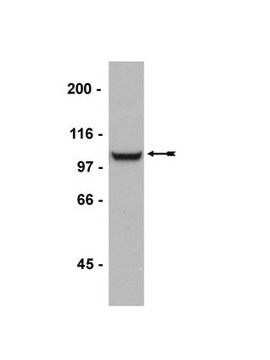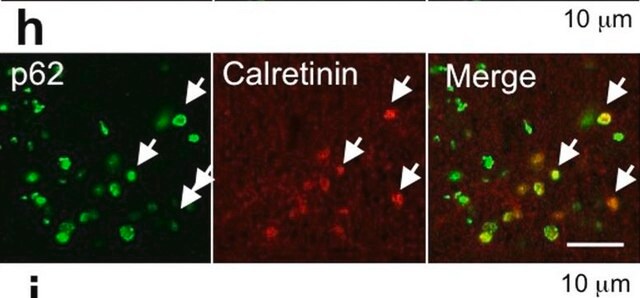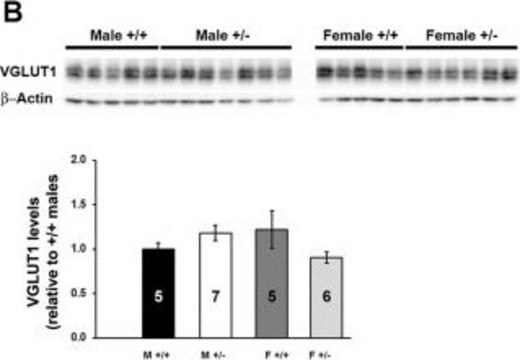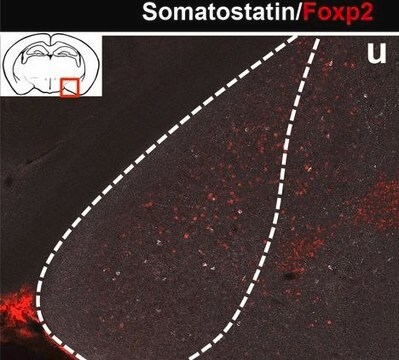AB1506
Anti-Glutamate Receptor 2 & 3 Antibody
Chemicon®, from rabbit
Synonim(y):
AMPA-selective glutamate receptor 2, AMPA-selective glutamate receptor 2, glutamate receptor 2, glutamate receptor, ionotropic, AMPA 2
About This Item
Polecane produkty
pochodzenie biologiczne
rabbit
Poziom jakości
forma przeciwciała
affinity isolated antibody
rodzaj przeciwciała
primary antibodies
klon
polyclonal
oczyszczone przez
affinity chromatography
reaktywność gatunkowa
hamster, mouse, human, guinea pig, monkey, gerbil, rat
producent / nazwa handlowa
Chemicon®
metody
immunocytochemistry: suitable
immunohistochemistry (formalin-fixed, paraffin-embedded sections): suitable
immunoprecipitation (IP): suitable
western blot: suitable
numer dostępu NCBI
numer dostępu UniProt
Warunki transportu
wet ice
docelowa modyfikacja potranslacyjna
unmodified
informacje o genach
human ... GRIA2(2891)
Opis ogólny
Specyficzność
Immunogen
Zastosowanie
A previous lot was used on paraformaldehyde or paraformaldehyde/glutaraldehyde fixed tissue with light and electron microscopy. Cryostat and vibratome sections can be used with or without Triton X-100 treatment. Final concentrations used were 1-3 µg/mL.
Immunoprecipitation:
When linked to immobilized Protein A, a previous lot of this antibody immunoprecipitated detergent-solubilized receptor from brain or transfected cells.
Neuroscience
Neurotransmitters & Receptors
Jakość
Western Blot Analysis:
1:1000 dilution of this antibody detected glutamate receptor 2 & 3 on 10 μg of rat brain lysate.
Opis wartości docelowych
Postać fizyczna
Przechowywanie i stabilność
Reconstitute to 500 μL with sterile distilled water. Store reconstituted material frozen (-20°C or -80°C) in undiluted aliquots for up to six months. Diluted antibody containing 0.1% sodium azide for Western blot analysis can be stored for several weeks at +2-8°C and reused repeatedly.
Handling Recommendations: Upon first thaw, and prior to removing the cap, centrifuge the vial and gently mix the solution. Aliquot into microcentrifuge tubes and store at -20°C. Avoid repeated freeze/thaw cycles, which may damage IgG and affect product performance.
Komentarz do analizy
Human brain tissue and extracts from mouse brain and rat brain tissue.
Informacje prawne
Oświadczenie o zrzeczeniu się odpowiedzialności
Nie możesz znaleźć właściwego produktu?
Wypróbuj nasz Narzędzie selektora produktów.
polecane
Hasło ostrzegawcze
Warning
Zwroty wskazujące rodzaj zagrożenia
Zwroty wskazujące środki ostrożności
Klasyfikacja zagrożeń
Acute Tox. 4 Dermal - Acute Tox. 4 Inhalation - Acute Tox. 4 Oral - Aquatic Chronic 3
Kod klasy składowania
13 - Non Combustible Solids
Klasa zagrożenia wodnego (WGK)
WGK 3
Temperatura zapłonu (°F)
Not applicable
Temperatura zapłonu (°C)
Not applicable
Certyfikaty analizy (CoA)
Poszukaj Certyfikaty analizy (CoA), wpisując numer partii/serii produktów. Numery serii i partii można znaleźć na etykiecie produktu po słowach „seria” lub „partia”.
Masz już ten produkt?
Dokumenty związane z niedawno zakupionymi produktami zostały zamieszczone w Bibliotece dokumentów.
Produkty
The term neurodegeneration characterizes a chronic loss of neuronal structure and function leading to progressive mental impairments.
Nasz zespół naukowców ma doświadczenie we wszystkich obszarach badań, w tym w naukach przyrodniczych, materiałoznawstwie, syntezie chemicznej, chromatografii, analityce i wielu innych dziedzinach.
Skontaktuj się z zespołem ds. pomocy technicznej







